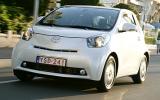What is it?
This is ‘the world’s smallest premium four-seater’ according to Toyota. It is also one of the most innovative small cars to have entered production.
The Toyota iQ was also created as part of the company’s New Small Car strategy, which aimed to “revolutionize vehicle packaging”. Toyota engineers also sum up the iQ as a “car with A-segment dimension, performance surpassing a B-segment car and interior and exterior quality in line with a C-segment car or higher”.
The Toyota iQ measures 2985mm from nose to tail and sits on a unique front-engined platform. Underpinning the iQ concept was the repositioning of the front wheels so that they are located ahead of the engine, achieved using a differential mounted forward of the engine’s crankshaft.
Toyota says this allowed it to reduce the typical distance from the tip of the front bumper to the accelerator by 120mm – extra space, which has found its way into the cabin.
To keep the intrusion into the cabin at a minimum, the iQ gets a high-mounted steering rack, with centre take-off for the column and an ultra-compact climate control unit, which is powerful enough to meet Toyota’s standards for the Middle East.
The Toyota iQ also uses a very thin, flat fuel tank mounted under the floorpan. The front chassis members are closer together than normal, allowing improved wheel articulation and a very tight turning circle. Weight has been kept down to between 860 and 895kg.
The launch engine will be a 68bhp 1.0-litre, three-pot petrol unit driving a five-speed manual. A new six-speed CVT box is optional. Next year a 1.33-litre petrol engine with a start-stop system will be offered. The UK will not get the 1.4-litre diesel iQ.
What’s it like?
While the Toyota iQ’s engineering is highly unusual, the driving dynamics are not. Despite being very short, the iQ drives like a much larger machine. It might be more expensive, but is also undoubtedly superior to the Smart.
There are three reasons for this. Firstly, the shoulder room in the wide, spacey cabin almost matches that of Toyota Auris. Secondly, the Toyota iQ is impressively refined. But most importantly, the car is very stable even at higher motorway speeds.
It avoids the Smart’s rather tiptoe, understeery manner and is much more impressively planted on the road. On the French autoroutes, the Toyota iQ was unaffected by passing lorries and coaches and passenger voices hardly have to be raised at a 100kmh (60mph) cruise.
However, despite the huge windscreen and doors, the over-shoulder view is poor. The thick B-pillar and rear ‘porthole’ window make angled junctions a bit tricky.
We sampled both the manual 1.4-litre diesel and the 1.33-litre petrol with a CVT ‘box - the petrol version is due in the UK next year - and both engines gave the Toyota iQ decent big-car performance. The 1.33 and CVT was an impressive combination offering surprisingly muscular performance with two up and some heavy luggage, even when climbing hills.
The CVT box is very clean shifting and there’s none of the momentary lag and intrusive engine braking that still upsets the Smart’s forward progress. However, when in ‘eco’ mode, the box shifts into top gear very quickly, leaving the engine on the point of labouring at urban speeds.
























































Join the debate
Add your comment
Re: Toyota iQ
Still can't get on with the look of the iQ. The width just looks wrong to me and I feel the same about the Scirocco.
The Cygnet is crazy. Good way to get the average CO2 down for Aston, but I'd be a bit embarrassed owning one. Imagine saying you own an Aston and then showing someone that. They'd kill themselves laughing.
Re: Toyota iQ
Dont worry, surely it wont be long before you can buy a complete kit from ebay to transform your iq into a cignet for a small fraction of the price of a real one.
Re: Toyota iQ
The trouble with the IQ is that it looks like a cheap rip-off of an Aston Martin...